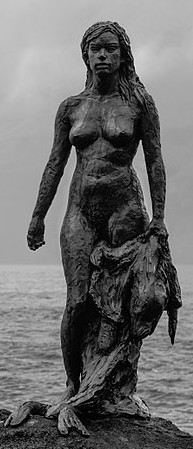The Alluring Creatures Swimming Through Our Global Folklore (Part 1)
This is a first in several blog posts about water-dwelling women from folklore and mythology. Because they tend to be very popular creatures in the literary world these days, I’m starting with mermaids, the female variety of merfolk. Then I discuss their close mythological cousins.
Mermaids
Merfolk have been swimming through the collective human imagination for millennia, dating at least as far back as Mesopotamia and Ancient Babylon. Male merfolk (what we’d call mermen) dominated the earliest stories, but by 1,000 B.C. mermaids started taking over the narratives. Around 100 B.C., the ancients depicted the goddess Atargatis of northern Syria on a coin as a fish with a woman’s head.
You might find it strange that mermaids have a Middle Eastern origin, but we need to remember that the Mediterranean Sea was the source of many of humankind’s original notions about life at sea. Mermaids filtered into Western European folkore much later. The English, for example, first depicted them around 1078, when an image appeared in the Norman chapel in Durham Castle.
Merfolk and mermaids in particular are an amazingly cosmopolitan part of folklore, appearing in the Far East, Southeast Asia and Africa. Long before mermaids made their way into the folklore of Britain, they were part of Chinese folklore. In fact, the Chinese mentioned merfolk dating back as far as the 4th century B.C.

Some folktales depict mermaids as benevolent, others as malicious. The idea that they lure sailors or other men to their deaths is common, but so are other stories of mermaids rescuing, helping and/or falling in love with human men.
The Nereids and Oceanids
The Nereids are sea nymphs in Greek mythology, a nymph being a minor female nature deity. There are fifty of them, all daughters of the Greek gods Nereus and Doris. Some artists depict them with mermaid-like tails, but my sense is that Greeks typically viewed them as beautiful women with normal features, including legs.
In a way, the Nereids are like mermaids with none of the fascinating downsides. The Greeks typically viewed them as benevolent, helping sailors survive deadly storms. They dwell with their father in a golden castle in the depths of the Aegean Sea and they are specifically associated with the Mediterranean Sea.
In contrast, the Oceanids are less well-defined, being nymphs living in many different bodies of water, though often associated with oceans. They are the daughters of the Titans Oceanus and Tethys and appear to be innumerable. Some view them as the personification of springs. The poet Hesiod gives them a much wider range, saying they are “dispersed far and wide” and everywhere “serve the earth and the deep waters.” Some associate them with salt water; like I said, the nature of these beings is hard to pin down.
The Naiads
Compared with the Oceanids, the Naiads are easier to define, being nymphs who live in bodies of fresh water such as fountains, wells, springs, streams, and brooks. Like many people, the Naiads can be dangerous if you cross them. There is the case of Nomia, who blinded her shepherd lover for being unfaithful to her. There’s also the case of Heracles’s companion Hylas. The Naiads kidnapped him, fascinated by his beauty. It’s unclear what happened to him, though some say he stayed willingly with the Naiads.

Some sources classify the Naiads according to the bodies of water in which they dwell:
The Crinaeae – Fountains and wells
The Limnades – Lakes
The Pegaeae – Springs
The Potameides – Rivers
The Eleionomae – Wetlands
Naiads are are not necessarily immortal. Some sources say, for example, that the destruction of their water source could kill them. For example, if a spring dries up, the associated Naiad was thought to die along with it.
Sirens
In Greek mythology, the Sirens are like mermaids gone bad, luring nearby sailors toward sharp rocks with their enchanted singing in order to cause shipwrecks. In more modern times, many stories and illustrations portray them as having fish tails, like mermaids. The original sources, however, showed them as a combination of women and birds.
Selkies

Selkies are part of Scottish mythology. They can change from seals to humans (a form of therianthropy) by removing their seal skins when they come up onto land. There are also male selkies, just as there are mermen, but most tales focus on the female varieties.
In selkie folktales, a human man typically steals a female selkie’s skin and then, once he finds her naked on the sea shore, forces her to become his wife. After years of captivity, the selkie wife discovers the skin that her husband has been hiding and then returns to the sea, abandoning her family.
Last Word
Those are the fundamentals of mythological women in the water. There are other categories we could add, but I think this covers the most commonly known legends. In Part 2, we’ll start looking at the symbolic meaning of these myths and what they can tell us about the human condition.
An Addendum
By the way, I stumbled over a post that contains an alphabetical list of water creatures. I like it as a basic primer for those who want a quick overview of the many water creatures inhabiting our collective consciousness.
The images used in this post are from the following sources:
Mermaid
A mermaid sits on a rock by the seashore
Nymph of the Spring
Selkie statute
The post The Alluring Creatures Swimming Through Our Global Folklore (Part 1) appeared first on The Tollkeeper.



